|
John J. Andrew (1858 - 1927)
Father of the Belfast Dental School
and Microscopist
Peter B. Paisley, Sydney, Australia
Image right: From the British Dental Journal: JJ Andrew, taken at the annual general meeting in Belfast at the start of his presidential year.
|
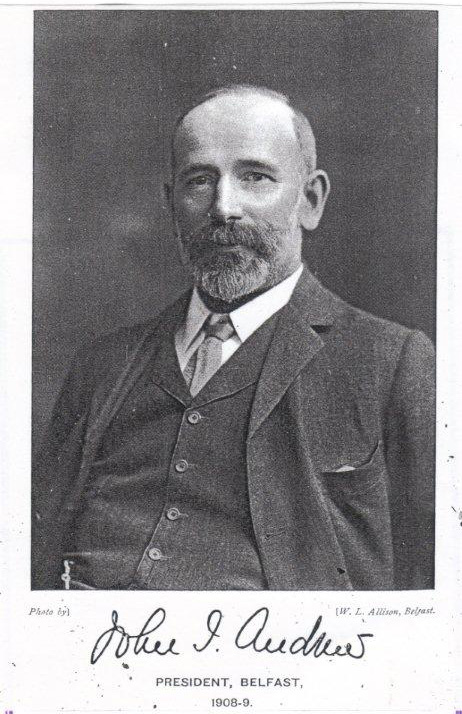
|
Dentistry is a specialty, with sub-specialties. World wide, few can
afford it: in the context of general anatomy, its range is small. It
hardly springs to mind as central to mainstream endeavour. In the
19th and early 20th centuries however it ranged through
many burgeoning fields – microbiology, microscopy, chemistry,
anaesthetics, histology, anthropology, radiology, and more. Its
forensic fame spread beyond the courts to fiction and the cinema: a
spectacular real example was arrest in 1909 at the Argentine border,
for robbery and murder, of the German consul to Chile - dental
evidence proved he faked his death, substituting an innocent victim’s
body (the hapless janitor). And it was essentially dental evidence
which debunked the notorious Piltdown man forgery. In February 1919
a German spy was shot, who concealed microphotographic data in a
tooth crown. Less sensationally, in the later nineteenth century it
was dentists, as much as anyone, who worked at the frontiers of
microscopical research.
The Belfast dentist J. J. Andrew, active in clinical practice and
many academic fields throughout his working life, keenly promoted
microscopy in dental teaching and research. The man and his work now
seem forgotten: the earliest published history (Stoy, 1951) of the
Queen’s University Belfast Dental School, omits any mention of
him. Strange - it was Andrew’s plans for such a school which
stimulated its foundation in 1919. I do not much discuss university
and professional politics, but Andrew espoused both. He joined the
British Dental Association in 1884, remaining a highly active member
until his death. An Irish branch was inaugurated in 1887: Andrew
became its president in 1899, and was elected president of the
general Association in 1908. At general meetings he often presented
slides, and he became chairman of the Association’s
microscopical section in 1899, when he addressed members at length on
the importance of bacteriology. Already in 1892 he had demonstrated
sectioning and mounting of both calcified and decalcified hard tissue
specimens, at the Association’s Manchester meeting.
Born in 1858 in Tillicoultry, Scotland, where his father was minister
of the evangelical church, his vocational education was in Dundee
(then a college of St. Andrew’s University) and London, at the
Royal Dental and Middlesex hospitals, excelling as a student with a
strong interest in histology. He qualified in 1882, and moved to
Belfast to commence private dental practice.
His first Belfast residence at 2 Belgravia St. lay within easy
walking distance of Charles Elcock’s house at 10 Dunluce
Avenue: of Elcock’s foraminifera mounts, Bracegirdle says they
“are of a quality which has never been exceeded, and rarely
equalled”. Later, Andrew moved to a splendid house at 23
University Square, some two minutes’ walk from Queen’s
College (later University) anatomy department, and a like distance
from the Belfast Field Naturalists’ Club’s president
(William Gray) in Mount Charles. The Students’ Union building
– ideal in size and configuration for an international
conference – lay directly opposite his residence, and he
secured its use for the Dental Association general meeting in
Belfast, which enjoyed resounding success under his presidency. Andrew took his seat as president “amidst great cheering”.
Scientific excellence was combined with touches of local colour, for
instance presentation to Association dignitaries of silver potato
rings, and Andrew led an excursion to the Giant’s Causeway. He
also led a visit to The Harland & Wolff shipyard (not an easy
achievement, for security reasons) where members witnessed early
construction of RMS Titanic. Replying to the loyal toast at the annual dinner, Sir Thomas Andrews, privy
councillor of Ireland and father of the Titanic's naval architect, said of the
new Dental Association president, "there was no man more respected in
Belfast".
Both Elcock and Andrew were members of the Field Club, as was W. A.
Firth, already known for diatom mounts. I found no record of
foraminifera mounts by Andrew, but probably he made some, since
Ulster is a rich source of such material, both fossil and living. Like many, he made fern mounts, presenting some to the Club. In 1965, the Irish Naturalists' Journal (vol.15, p.349)
noted that in 1927 there was a bequest of over 100 Andrew diatom slides. I
assume this came from his son, or his widow, and was to the Belfast Field
Naturalists' Club. The details, unfortunately, are unknown. It may have been a
collection of his own mounts, but if it was mixed, then slides by W.A. Firth and
Andrew's fellow dentist Gatrell were likely inclusions. Diatoms featured prominently in toothpaste manufacture: Andrew made enough
diatom mounts to advertise some as exchange offers in the April 1884
Science Gossip (p.96). In the same edition (p.91) there is a query
asking for the best mounting medium for hard tissues, “one in
which they will not change, and.…their minute structure will
not be lost….that is lacunal canaliculi and dentinal tubules,
&c”. This is signed “JJA”, and I think can
only have come from him. It shows an early concern for lasting
mounts, such as those destined for teaching purposes. Glycerine
jelly, the “JJA” writer finds, is superior to balsam in
this respect (despite tending to leach a little lime salt from dental
sections). This certainly matches my Andrew slides, several of which use glycerine jelly. Teeth obviously were his main focus,
particularly their developmental and comparative microanatomy (he
served at the Children’s Dental Hospital and the school dental
programme). Some of his slides of developing teeth are shown below.
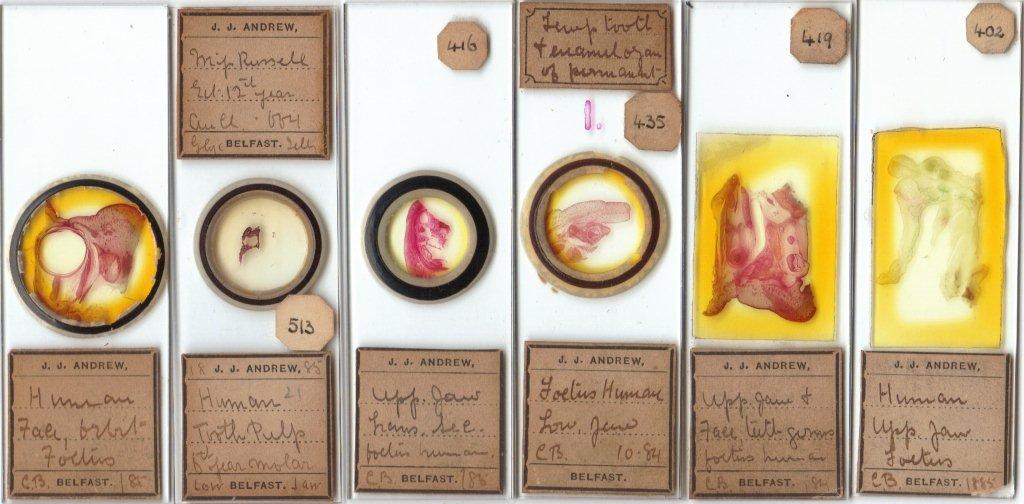
Early Belfast slides: Andrew was still mostly using Canada Balsam for mounting,
and clearly had not received a satisfactory answer
to his 1884 Science Gossip
query on alternative mountants.
A man of many parts, he was a keen marksman, competing annually at
the Bisley rifle competition: I found no record of overseas safaris,
and while it is tempting to think he shot his own specimens, the
slides shown here are the probable results of services rendered to
the Belfast zoo. His want entries in Science Gossip exchange columns
were as often for a wide range of literary material as for specimens
or slides, in contrast to his slide-making colleague S.M. Malcolmson,
who usually sought slide exchanges.
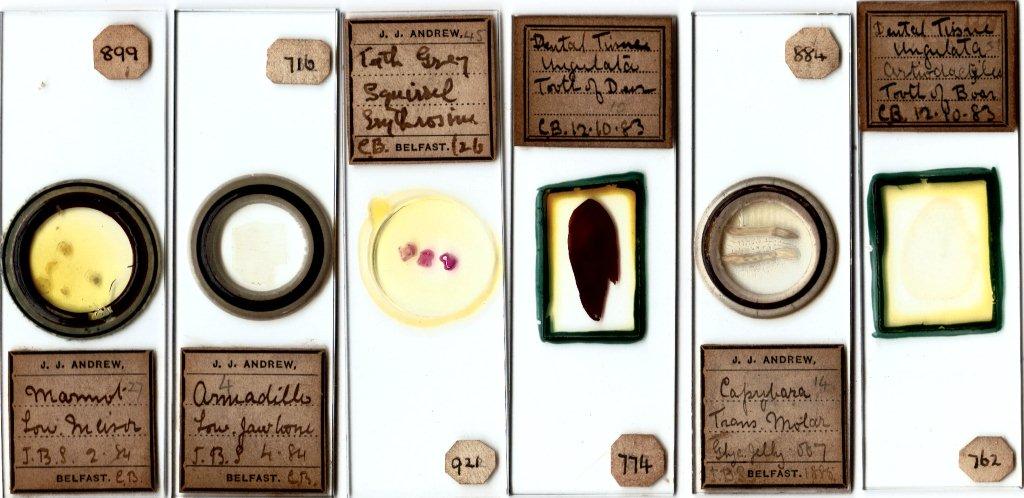
Wide ranging comparative dental microanatomy.
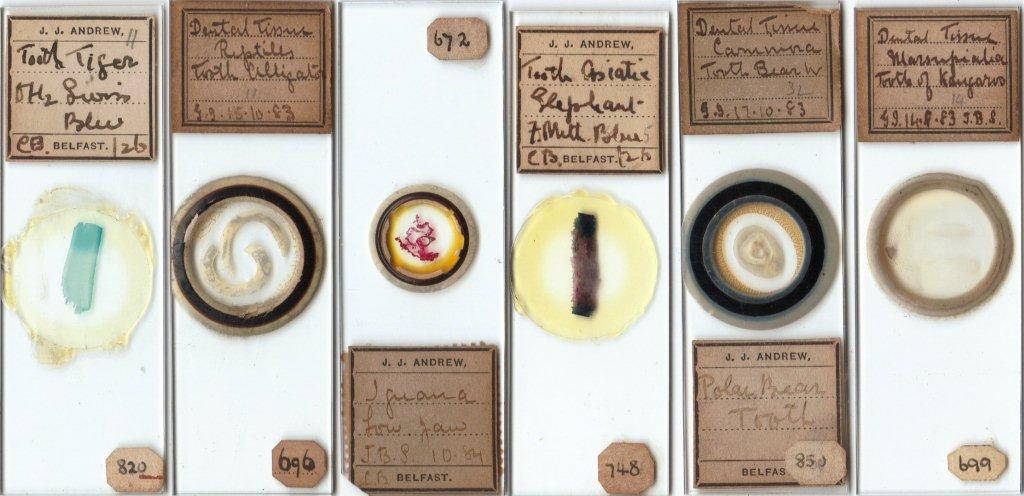
Bigger game, whose provenance is probably the Belfast zoo. Even a crack rifle
marksman like Andrew seems unlikely to have been rash enough to stalk a wild
polar bear, merely to acquire one tooth. Symington's initials (JBS) on many
slides indicate their use for teaching and research in the Queen's Anatomy
Department.
By Andrew’s time, decalcification techniques were making tooth
sections (as opposed to ground specimens) easier. Always one to
apply new methods, his research also involved the rapidly expanding
milieu of X-rays. Within months of Rontgen’s discovery of
X-rays, the new technique was in the dentists’ repertoire, but
its research deployment on developing teeth was surprisingly tardy. It was at Andrew’s urging that his friend Johnson Symington
(Professor of Anatomy in Belfast 1893 - 1916) published the first
X-ray textbook (1908) of developing teeth, a fact acknowledged by
Symington, who remarked “Mr. Andrew is a very old friend of
mine, and I could not refuse to do my best to oblige him”
(British Dental Journal, vol.29 p.957). Andrew himself presented a
paper (1908) illustrating the clinical value of X-rays.

From Andrew's 1908 paper read at the British Dental Association's Belfast meeting.
Many Andrew slides were used for teaching and research at Belfast. Their subject matter extended well beyond dentistry, as examples
shown here testify.
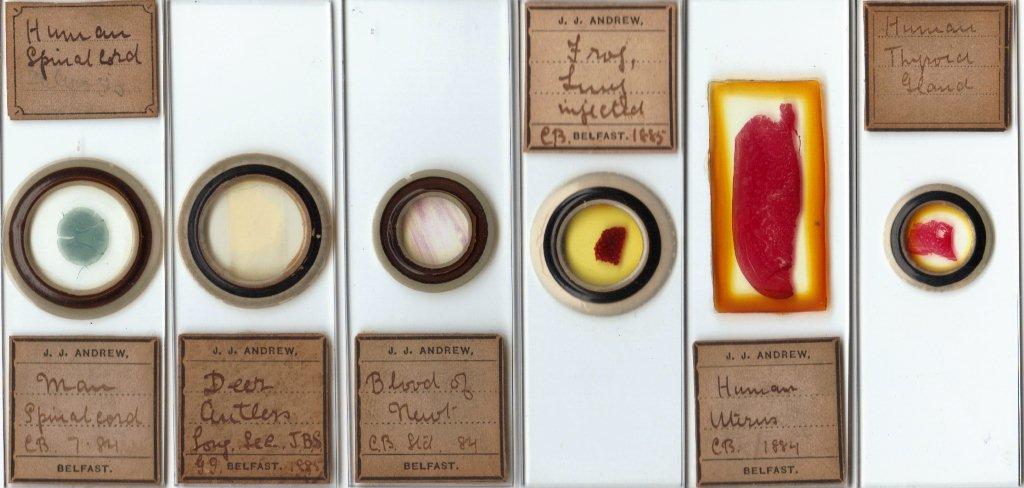
Non dental histology slides prepared by Andrew.
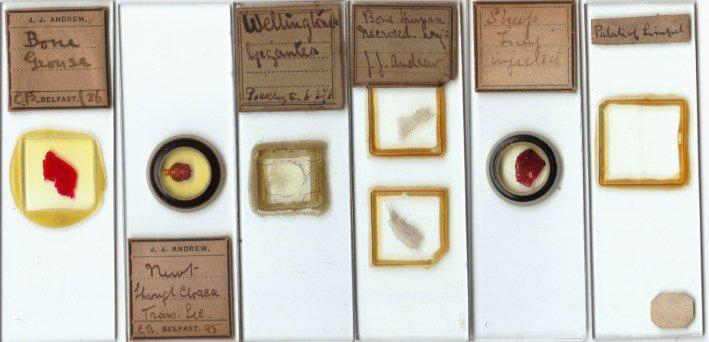
More Andrew histology. The Wellingtonia slide was made
by Andrew while still a student. He may have aquired his material from the
celebrated sequoia specimens planted in 1863 at Bentmore Botanic Gardens (SW
Scotland), or from Kew, while studying in London. Whatever the case, it is of
interest that the slide was acquired by Henry Pocklington, president of the
Leeds Microscopical Society.
Andrew’s son John followed in his father’s footsteps,
both as dentist and histologist. Some of his slides are shown below,
and he also made geological mounts, a few of which survive in the
Belfast museum.
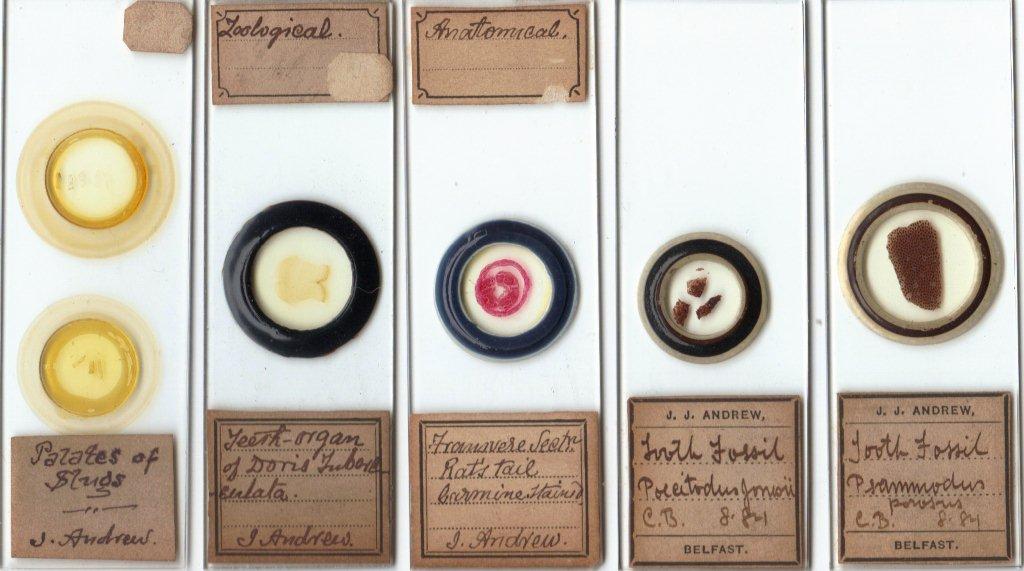
Like father, like son. Andrew junior also qualified as a dentist, and shared
his father's interest in histology, with a range extending well beyond teeth.
Two of Andrew senior's many fossil slides are shown here - it is not surprising
his son went on to pure geological preparations.
A fellow member of the Field Club, the physician S.M. Malcolmson, was
an active member of the Postal Microscopical Society, and contributor
to the anatomy department histology stock. Some slides have
handwritten labels indicating that Malcolmson and Andrew
collaborated.
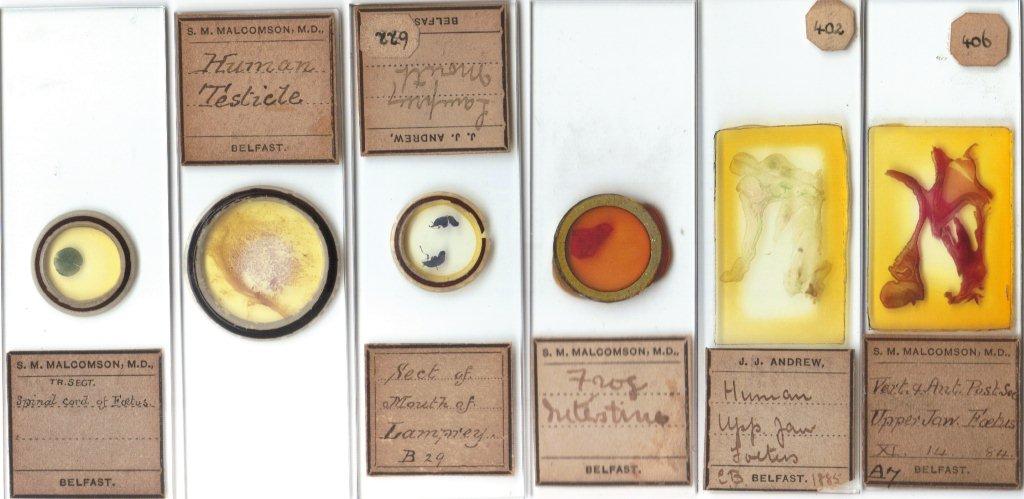
From left to right: two Malcolmson slides; a lamprey slide with labels and
handwriting of both men; frog intestine, with Malcolmson's label and Andrew's
handwriting; and two slides from a foetus dissected by Malcolmson and Andrew.
Dental pathology was of paramount importance to Andrew – ever
the dedicated clinician - and examples of such material are shown
below.
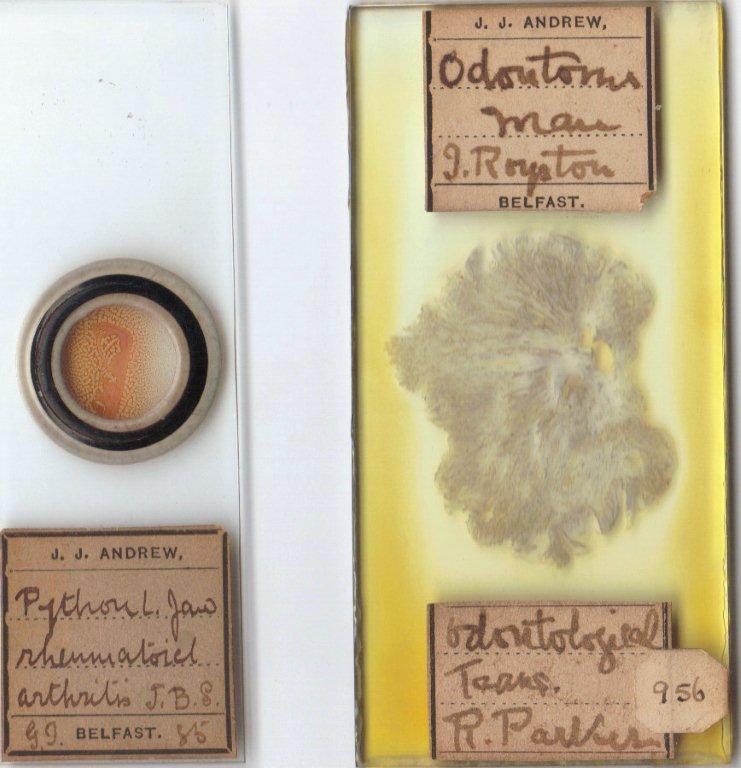
A splendid large mount by Andrew: the surgeon, Jonathan Royston, was known to
Andrew since their Middlesex Hospital days.
And the splendidly exotic: a python
with rheumatoid arthritis is surely one of the rarest subjects of
histology.
In the same context, he was a strong advocate of microbiology in
dentistry, and made bacterial preparations: one such has diamond
inscribed initials RCSI, denoting the Royal College of Surgeons in
Ireland. His presidential address to the British Dental Association
was largely devoted to bacteriology, with details of culture
techniques and slide preparation. A keen photographer, he won a
silver medal in 1890 for 6 landscapes in an Ulster Amateur
Photographic Society exhibition, and maintained microphotography
equipment, bacterial cultures, and a darkroom in his home. Often
visiting Dublin for meetings of the Irish branch of the British
Dental Association, he probably donated other slides there.

A slide of urinary "microbes". It contains mixed flora. (The RCSI inscription is
obscured by Andrew's label).
Andrew was a generous donor to charities and a discerning collector
of porcelain, ivories and contemporary paintings for his University
Square home. A keen golfer, he was closely involved in the Dental
Association’s inauguration of the Irish Golf Challenge Cup. He
was instrumental in founding the Royal Victoria Dental Hospital
(Belfast), and his friend Symington, secretary to the Queen’s
University senate, promoted his plans for a dental school: these
however were not adopted until 1919, the first staff commencing
lectures in 1920. Original ideas for an autonomous dental school
were usurped by Thomas Walmsley – by then professor of Anatomy
– who seems to have subsumed the whole project under his own
aegis.

Tragedy dogged him: in 1889 his first wife Hettie died young in
Crawfordsburn hospital (probably of eclampsia) as did a prematurely
born son. Illness (probably myocardial infarction) rendered him
inactive for several months in 1910, and he could not attend the
international dental conference in Berlin, to whose organisation he
had contributed much. Highly active again by 1914, he had worked
hard at helping to secure the international conference for London:
scarcely had this begun when it was brutally cut short by the
outbreak of war. On his premature death from a stroke in 1927, the
press agreed “we have lost one of our best men”.
During Andrew’s lifetime, preparation of university teaching
slides became internalised, in the hands of permanent employee
technicians. Free market preparers like Amos Topping, common
suppliers up to the turn of the century, were being supplanted. Firms like Biosil or Harris Biological rely heavily nowadays on
schools and technical colleges for business, and in universities, the
days of slide acquisition from commercial firms like Topping or
Norman, or individuals like Andrew, have largely vanished. My
collection represents early Belfast work by Andrew, and is almost
certainly only a small fraction of his overall output. Dentistry,
photography and polariscopy in his day all constantly involved
chemical experiment (even asbestos was tried for filling teeth!) so
that chemical slides, for instance, were a likely Andrew interest. Many old slides end in rubbish bins, and I’m fortunate to have
saved my Andrew collection of some 130 slides from such a fate. I
cannot end, therefore, without mention of my teacher and friend James
Scott, long head of dental anatomy at Queen’s. Seeing my
interest, he urged me to rescue them. Here is a link leading to
Andrew himself: the celebrated Howard Mummery was Andrew’s
close friend since their London days, and the British Dental
Association instituted an international award for dental research,
the Mummery Prize. Jimmy Scott was its first winner.
Comments
to the author will be welcomed.
Acknowledgements
James Henderson Scott (1913 -1970): anatomist, poet, maverick
theologian, irrepressible wit, teacher, and friend.
Footnote on Irish preparers
There is little information on Irish preparers: Andrew is an example
of one who has been unknown, and most remain under documented. There
are many reasons. Currently (exemplified by web sites like eBay)
there seems to be no collecting interest in Ireland. Historically,
Ireland lay largely outside mainstream British science – as
Kinahan remarked in the first of a series of articles for Science
Gossip, the natural history of its west in particular was as foreign
to England as that of central Africa. Recent factors also militate
against research. Old Irish newspapers are unavailable on line; a
huge amount of data was lost during the war of independence and the
civil war; and societies like the Belfast Field Naturalists’
Club, or its counterpart in Armagh, do not now communicate with the
outside world. Andrew is a rare example where extensive research (at
a distance, anyway) is not hopeless, due largely to non-Irish
sources.
Sources
Ancestry.com
Science Gossip
The Journal of the British Dental Association (most of the information in this article has been gleaned from it).
B. Bracegirdle, 'Microscopical Mounts and Mounters', Quekett Microscopical Club, London, 1998.
P.J. Stoy: A History of the Queen’s University Belfast Dental
School (Ulster Medical Journal, 1951).
See Brian Stevenson’s Micscape article on William Gatrell for
the nexus between dentistry, diatoms and toothpaste (particularly
“Sozodont”).
Microscopy UK Front
Page
Micscape
Magazine
Article
Library
© Microscopy UK or their
contributors.
Published
in the May 2010 edition of Micscape
Magazine.
Please report any Web problems or offer general comments
to the
Micscape
Editor
.
Micscape is the on-line monthly magazine of the Microscopy
UK website at
Microscopy-UK
.
©
Onview.net Ltd, Microscopy-UK, and all contributors 1995
onwards. All rights reserved. Main site is at
www.microscopy-uk.org.uk
.











